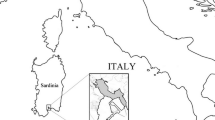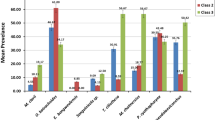Abstract
Between May and September 2006, 640 specimens of the rabbitfish Siganus rivulatus Forsskål (Teleostei, Siganidae) were examined for infections with intestinal helminths. These fishes were caught in the Red Sea off the coast of Sharm El-Sheikh, South Sinai, Egypt, examined in a field laboratory and separated into three size groups of regular length intervals. Only three species of helminths were recovered: the trematode Gyliauchen volubilis Nagaty, 1956 (Gyliauchenidae Fukui, 1929), the acanthocephalan Sclerocollum rubrimaris Schmidt et Paperna, 1978 (Cavisomidae Meyer, 1932) and the nematode Procamallanus elatensis Fusco et Overstreet, 1979 (Cucullanidae Cobbold, 1864). The distribution of these helminths along the intestine of S. rivulatus, in all patterns of single and concurrent infections and the corresponding prevalences and intensities of infection in the different size groups of the fish were recorded. In single infections, each parasite species was found distributed in a well-defined fundamental niche along the intestine of Siganus rivulatus, and a distinct partial overlap between the niches of G. volubilis and Sclerocollum rubrimaris was observed. In concurrent infections with these two species, their fundamental niches were significantly reduced, probably being affected by interactive site segregation and individuals of each species were found segregated in a restricted realised niche. In all other patterns of concurrent infections, each parasite species was normally found in its original fundamental niche. The prevalences of these parasites in the fish examined were relatively low and somewhat similar. In all patterns of single and concurrent infections, the intensity of infection was directly related to fish size. In concurrent infection with G. volubilis and S. rubrimaris, a significant decline was observed in the intensities of both species in the different size groups of the fish, but, in all other patterns of concurrent infections, no significant change in intensity was observed. These observations suggest that the interaction between G. volubilis and S. rubrimaris is probably a negative and symmetrical one. The mode of transmission of these parasites to the fish is also discussed.
Similar content being viewed by others
References
Amin O.M., Heckmann R.A., Van Ha N. 2004. On the immature stages of Pallisentis (Pallisentis) celatus (Acanthocephala: Quadrigyridae) from occasional fish hosts in Vietnam. The Raffles Bulletin of Zoology, 52, 593–598. http://rmbr.nus.edu.sg/rbz/biblio/#522.
Awachie J.B.E. 1968. On the bionomics of Crepidostomum metoecus (Braun, 1900) and Crepidostomum farionis (Müller, 1784) (Trematoda: Allocreadiidae). Parasitology, 55, 307–324.
Chaicharn A., Bullock W.L. 1967. The histopathology of acanthocephalan infections in suckers with observations on the intestinal histology of two species of catostomid fishes. Acta Zoologica, 18, 19–42.
Cribb T.H. 2005. Family Gyliauchenidae Fukui, 1929. In: (Eds. A. Jones, R.A. Bray and D.I. Gibson) Keys to the Trematoda. Vol. 2. CABI Publishing and the Natural History Museum, Wallingford, UK, 665–678.
De N.C., Maity R.N. 2000. Development of Procamallanus saccobranchi (Nematoda: Camallanidae), a parasite of freshwater fish in India. Folia Parasitologica, 47, 216–226.
Diamant A. 1989. Ecology of the acanthocephalan Sclerocollum rubrimaris Schmidt and Paperna, 1978 (Rhadinorhynchidae: Gorgorhynchinae) from wild populations of rabbitfish (genus Siganus) in the northern Red Sea. Journal of Fish Biology, 34, 387–397. DOI:10.1111/j.1095-8649.1989.tb03321.x.
Dobson A.P. 1985. The population dynamics of competition between parasites. Parasitology, 92, 675–682.
Dobson A.P., Roberts M. 1994. The population dynamics of parasitic helminth communities. Parasitology, 109, S97–S108.
Dzikowski R., Paperna I., Diamant A. 2003. Multi-annual changes in the parasite communities of rabbitfish Siganus rivulatus (Siganidae) in the Gulf of Aqaba, Red Sea. Helgoland Marine Research, 57, 228–235. DOI: 10.1007/s10152-003-0139-1.
Evans N.A 1977. The site preferences of the two digeneans, Asymphylodora kubanicum and Sphaerostoma bramae, in the intestine of the roach. Journal of Helminthology, 51, 197–204.
Fowler J., Cohen L., Jarvis P. 2001. Practical statistics for field biology. John Wiley & Sons, Chichester, UK, 259 pp.
Froese R., Pauly D. 2006. FishBase. World Wide Web electronic publication, www.fishbase.org, version 10/2006.
Fusco A.C., Overstreet R.M. 1979. Two camallanid nematodes from Red Sea fishes including Procamallanus elatensis sp. nov. from signaids. Journal of Natural History, 13, 35–40.
Halvorsen O., MacDonald S. 1972. Studies on the helminth fauna of Norway. XXVI: The distribution of Cyathocephalus truncatus (Pallas) in the intestine of the brown trout (Salmo trutta L.). Norwegian Journal of Zoology, 20, 265–272.
Hassanine R.M.El-S. 2006. Acanthocephalans from Red Sea fishes. Family Cavisomidae Meyer, 1932: the seasonal cycle of Diplosentis nudus (Harada, 1938) Pichelin et Cribb, 2001 in a definitive fish host, and a comment on Sclerocollum Schmidt et Paperna, 1978. Acta Parasitologica, 51, 123–129. DOI: 10.2478/s11686-006-0019-3.
Hine P.M., Francis R.I.C.C. 1980. Distribution of helminths in the digestive tracts of New Zealand freshwater eels. 3. Interspecific associations and conclusion. New Zealand Journal of Marine and Freshwater Research, 14, 349–356.
Hine P.M., Kennedy C.R. 1974. Observations on the distribution, specificity and pathogenicity of the acanthocephalan Pomphorhynchus laevis (Müller). Journal of Fish Biology, 6, 521–535. DOI: 10.1111/j.1095-8649.1974.tb04569.x.
Holmes J.C. 1973. Site segregation by parasitic helminths: interspecific interactions, site segregation, and their importance to the development of helminth communities. Canadian Journal of Zoology, 51, 333–347.
Kennedy C.R. 1976. Reproduction and dispersal. In: (Ed. C.R. Kennedy) Ecological aspects of parasitology. North Holland Publ. Co., Amsterdam, 143–160.
Kennedy C.R. 1985. Site segregation by species of Acanthocephala in fish with special reference to eels, Anguilla anguilla. Parasitology, 90, 375–390.
Lo C.M., Morand S., Galzin R. 1998. Parasite diversity/host age and size relationships in three coral-reef fishes from French Polynesia. International Journal for Parasitology, 28, 1695–1708. DOI: 10.1016/S0020-7519(98)00140-4.
Mackenzie K., Gibson D.I. 1970. Ecological studies of some parasites of plaice Pleuronectes platessa L. and flounder Platichthys flesus (L.). In: (Eds. A.E.R. Taylor and R. Müller) Aspects of fish parasitology. Blackwell Scientific Publications, Oxford, 1–42.
McDonough J.M., Gleason L.N. 1981. Histopathology in the rainbow darter, Etheostoma caeruleum, resulting from infections with the acanthocephalans, Pomporhynchus bulbocolli and Acanthocephalus dirus. Journal of Parasitology, 67, 403–409. DOI: 10.2307/3280564.
Nagaty H.F. 1956. Trematodes of fishes from the Red Sea. Part 7. On two gyliauchenids and three allocreadiids, including four new species. Journal of Parasitology, 42, 523–527. DOI: 10.2307/3274451.
Polyanskiy Yu.I. 1961. Zoogeography of parasites of the USSR marine fishes. In: (Eds. V.A. Dogiel, G.K. Petrushevskiy and Yu.I. Polyanskiy) Parasitology of fishes (English translation). Oliver and Boyd, Edinburgh and London, 230–246.
Poulin R. 1998. Evolutionary ecology of parasites: from individuals to communities. Chapman & Hall, London, 224 pp.
Poulin R. 2000. Variation in the intraspecific relationship between fish length and intensity of parasitic infection: biological and statistical causes. Journal of Fish Biology, 56, 123–137. DOI: 10.1111/j.1095-8649.2000.tb02090.x.
Poulin R. 2001. Interactions between species and the structure of helminth communities. Parasitology, 122, S3–S11.
Randall J.E. 1983. Red Sea reef fishes. IMMEl Publ. Co., London, 192 pp.
Rohde K. 1977. A non-competitive mechanism responsible for restricting niches. Zoologischer Anzeiger, 199, 164–172.
Rohde K. 1993. Ecology of marine parasites. CAB International, Wallingford, UK, 298 pp.
Rózsa L., Reiczigel J., Majoros G. 2000. Quantifying parasites in samples of hosts. Journal of Parasitology, 86, 228–232. DOI: 10.2307/3284760.
Sasal P., Niquil N., Bartoli P. 1999. Community structure of digenean parasites of sparid and labrid fishes of the Mediterranean Sea: a new approach. Parasitology, 119, 635–648. DOI: 10.1017/S0031182099005077.
Schmidt G.D., Paperna I. 1978. Sclerocollum rubrimaris gen. et sp. n. (Rhadinorhynchidae: Gorgorhynchinae), and other Acanthocephala of marine fishes from Israel. Journal of Parasitology, 64, 846–850. DOI: 10.2307/3279515.
Shaw D.J., Dobson A.P. 1995. Patterns of macroparasite abundance and aggregation in wildlife populations: a quantitative review. Parasitology, 111, S111–S133.
Shaw D.J., Grenfell B.T., Dobson A.P. 1998. Patterns of macroparasite aggregation in wildlife host populations. Parasitology, 177, 597–610. DOI: 10.1017/S0031182098003448.
Thomson J.D. 1980. Implications of different sorts of evidence for competition. American Naturalist, 116, 719–726.
Venard C.E., Warfel J.H. 1953. Some effects of two species of acanthocephalan on the alimentary canal of the largemouth bass. Journal of Parasitology, 39, 187–190. DOI: 10.2307/3274116.
Vidal-Martinez V.M., Kennedy C.R. 2000. Potential interactions between the intestinal helminths of the cichlid fish Cichlasoma synspilum from southeastern Mexico. Journal of Parasitology, 86, 691–695. DOI: 10.2307/3284949.
Williams E.H., Bunkley-Williams L., Dowgiallo M.J., Dyer W.G. 1991. Influence of collection methods on the occurrence of alimentary canal helminth parasites in fish. Journal of Parasitology, 77, 1019–1022. DOI: 10.2307/3282761.
Author information
Authors and Affiliations
Corresponding author
Rights and permissions
About this article
Cite this article
Hassanine, R.M.E.S., Al-Jahdali, M.O. Ecological comments on the intestinal helminths of the rabbitfish Siganus rivulatus (Teleostei, Siganidae) from the northern Red Sea. Acta Parasit. 52, 278–285 (2007). https://doi.org/10.2478/s11686-007-0030-3
Accepted:
Issue Date:
DOI: https://doi.org/10.2478/s11686-007-0030-3




